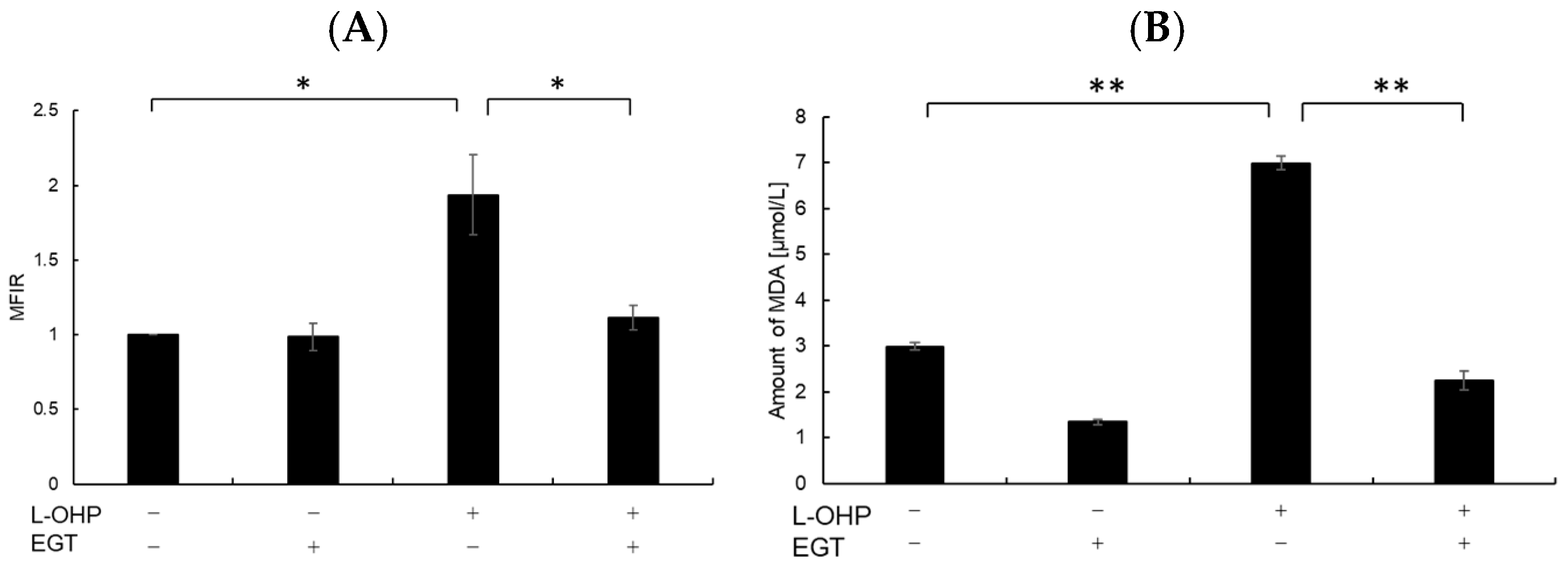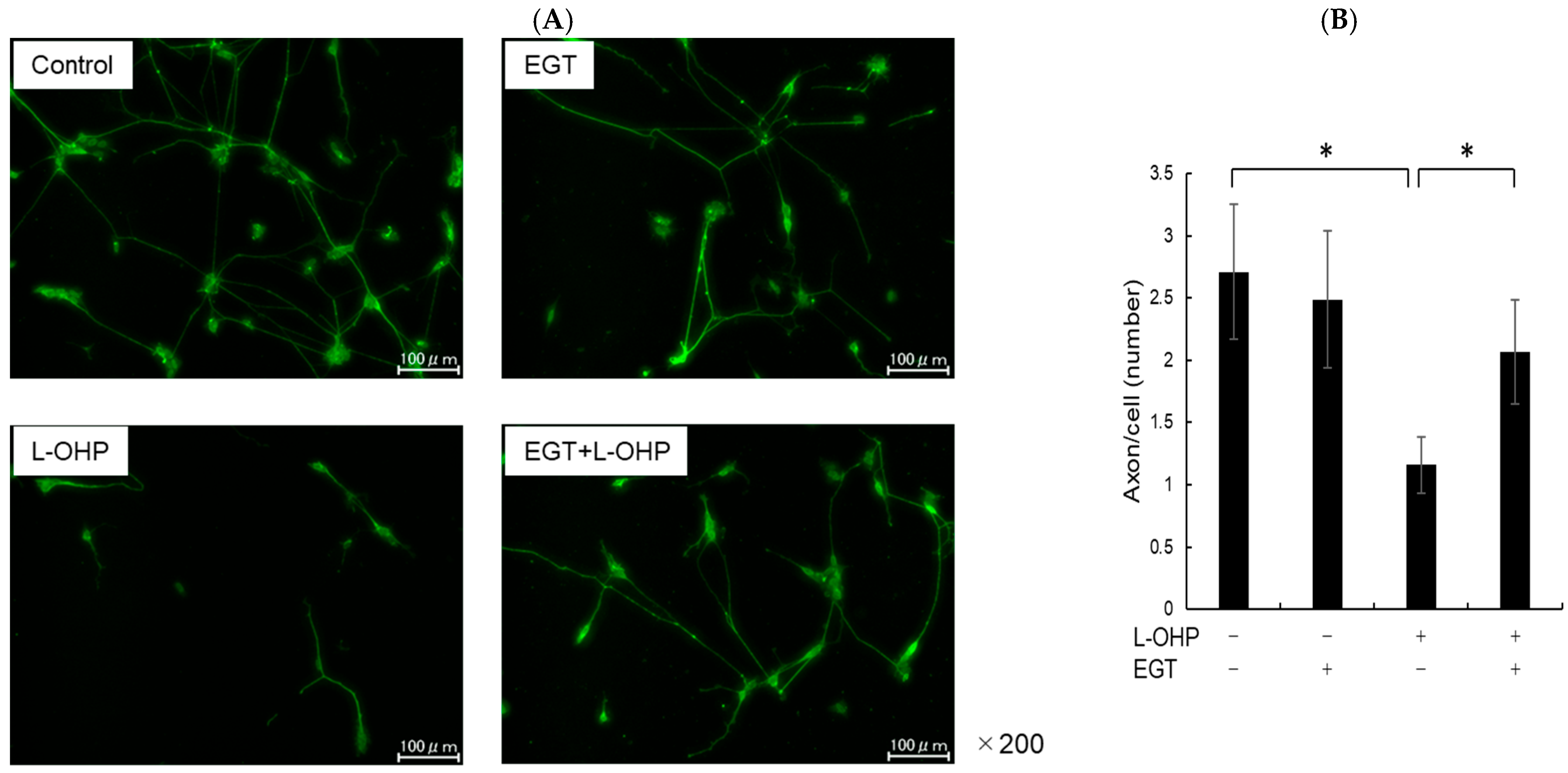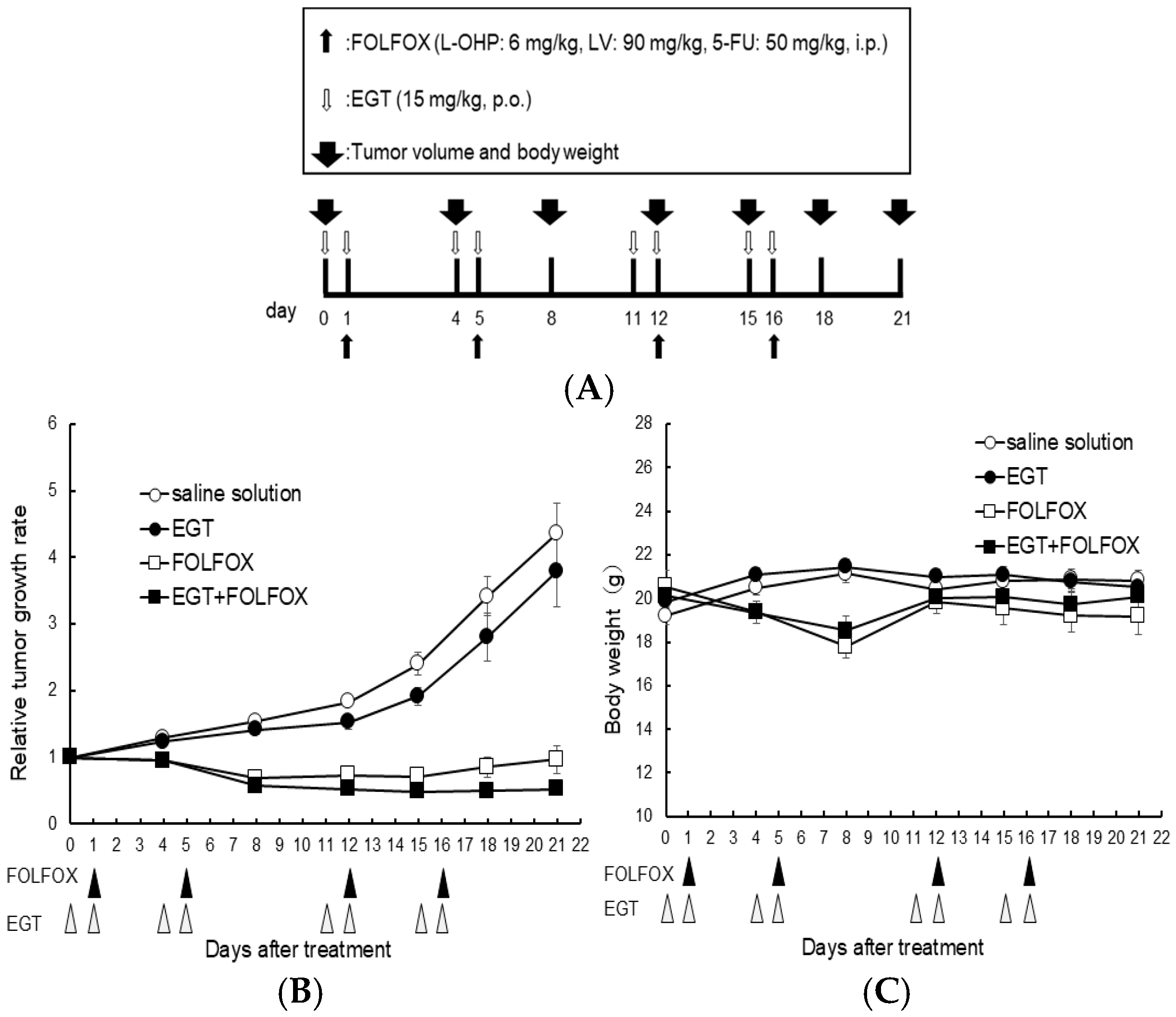Ergothioneine Attenuates Oxaliplatin-Induced Peripheral Neuropathy Without Compromising Antitumor Efficacy
Abstract
1. Introduction
2. Results and Discussion
2.1. EGT Protects SH-SY5Y Cells from Oxaliplatin-Induced Cytotoxicity via Anti-Apoptotic and Antioxidant Mechanism
2.2. EGT Preserves Neuronal Function in Differentiated SH-SY5Y Cells Under Oxaliplatin-Induced Neurotoxicity
2.3. EGT Does Not Adversely Affect the Antitumor Effect of L-OHP
2.4. Limitations
2.5. Future Directions
3. Materials and Methods
3.1. Cell Culture and Neuronal Differentiation
3.2. Sulforhodamine B (SRB) Cell Survival Assay
3.3. Annexin V–FITC/7-AAD Apoptosis Assay
3.4. Malondialdehyde (MDA) Assay
3.5. Reactive Oxygen Species (ROS) Assay
3.6. Western Blotting
| Reagents | Concentrations | Company |
|---|---|---|
| Tris trizma base | 25 mM | Sigma-Aldrich |
| KCl | 150 mM | FUJIFILM Wako Pure Chemical Corporation, Tokyo, Japan |
| EDTA-2Na | 5 mM | DOJINDO LABORATORIES |
| NP-40 alternative | 1% | FUJIFILM Wako Pure Chemical Corporation |
| sodium deoxycholate | 0.5% | FUJIFILM Wako Pure Chemical Corporation |
| SDS | 0.1% | FUJIFILM Wako Pure Chemical Corporation |
| Na3VO4 | 50 mM | FUJIFILM Wako Pure Chemical Corporation |
3.7. Immunofluorescence
3.8. Evaluation of Differentiated Neurons
3.9. In Vivo Tumor Xenograft Model and Treatment
3.10. Real-Time Quantitative PCR
3.11. Statistical Analysis
4. Conclusions
Author Contributions
Funding
Institutional Review Board Statement
Informed Consent Statement
Data Availability Statement
Acknowledgments
Conflicts of Interest
Abbreviations
| α-syn | α-synuclein |
| AD | Alzheimer’s Disease |
| Aβ | Amyloid-beta |
| ATP7a | A copper-transporting P-type ATPase 7a |
| ATP7b | A copper-transporting P-type ATPase 7b |
| CIPN | Chemotherapy-Induced Peripheral Neuropathy |
| DRG | Dorsal Root Ganglion |
| EGT | Ergothioneine |
| I-LV | Leucovorin |
| L-OHP | Oxaliplatin |
| MDA | Malondialdehyde |
| OCTN1 | Organic Cation/Carnitine Transporter 1 |
| OCTN2 | Organic Cation/Carnitine Transporter 2 |
| OIPN | Oxaliplatin-Induced Peripheral Neuropathy |
| PARP | Poly ADP-ribose Polymerase |
| PD | Parkinson’s Disease |
| QOL | Quality Of Life |
| RA | Retinoic Acid |
| ROS | Reactive Oxygen Species |
| RPLP0 | 60S acidic ribosomal protein P0 |
| UV | Ultraviolet |
References
- Cheng, L.; Eng, C.; Nieman, L.Z.; Kapadia, A.S.; Du, X.L. Trends in colorectal cancer incidence by anatomic site and disease stage in the United States from 1976 to 2005. Am. J. Clin. Oncol. 2011, 34, 573–580. [Google Scholar] [CrossRef]
- Siegel, R.L.; Miller, K.D.; Fedewa, S.A.; Ahnen, D.J.; Meester, R.G.S.; Barzi, A.; Jemal, A. Colorectal cancer statistics, 2017. CA Cancer J. Clin. 2017, 67, 177–193. [Google Scholar] [CrossRef]
- Mjos, K.D.; Orvig, C. Metallodrugs in medicinal inorganic chemistry. Chem. Rev. 2014, 114, 4540–4563. [Google Scholar] [CrossRef]
- Wlodarczyk, M.T.; Dragulska, S.A.; Camacho-Vanegas, O.; Dottino, P.R.; Jarzecki, A.A.; Martignetti, J.A.; Mieszawska, A.J. Platinum (II) complex-nuclear localization sequence peptide hybrid for overcoming platinum resistance in cancer therapy. ACS Biomater. Sci. Eng. 2018, 4, 463–467. [Google Scholar] [CrossRef]
- Yang, Y.; Zhao, B.; Gao, X.; Sun, J.; Ye, J.; Li, J.; Cao, P. Targeting strategies for oxaliplatin-induced peripheral neuropathy: Clinical syndrome, molecular basis, and drug development. J. Exp. Clin. Cancer Res. 2021, 40, 331. [Google Scholar] [CrossRef] [PubMed]
- Fujita, S.; Hirota, T.; Sakiyama, R.; Baba, M.; Ieiri, I. Identification of drug transporters contributing to oxaliplatin-induced peripheral neuropathy. J. Neurochem. 2019, 148, 373–385. [Google Scholar] [CrossRef]
- Ewertz, M.; Qvortrup, C.; Eckhoff, L. Chemotherapy-induced peripheral neuropathy in patients treated with taxanes and platinum derivatives. Acta Oncol. 2015, 54, 587–591. [Google Scholar] [CrossRef]
- Miaskowski, C.; Mastick, J.; Paul, S.M.; Topp, K.; Smoot, B.; Abrams, G.; Chen, L.M.; Kober, K.M.; Conley, Y.P.; Chesney, M.; et al. Chemotherapy-Induced Neuropathy in Cancer Survivors. J. Pain Symptom Manag. 2017, 54, 204–218.e2. [Google Scholar] [CrossRef]
- Chen, H.P.; Zhou, W.; Kang, L.M.; Yan, H.; Zhang, L.; Xu, B.H.; Cai, W.H. Intrathecal miR-96 inhibits Nav1.3 expression and alleviates neuropathic pain in rat following chronic construction injury. Neurochem. Res. 2014, 39, 76–83. [Google Scholar] [CrossRef] [PubMed]
- Siau, C.; Bennett, G.J. Dysregulation of cellular calcium homeostasis in chemotherapy-evoked painful peripheral neuropathy. Anesth. Analg. 2006, 102, 1485–1490. [Google Scholar] [CrossRef] [PubMed]
- Sittl, R.; Lampert, A.; Huth, T.; Schuy, E.T.; Link, A.S.; Fleckenstein, J.; Alzheimer, C.; Grafe, P.; Carr, R.W. Anticancer drug oxaliplatin induces acute cooling-aggravated neuropathy via sodium channel subtype Na(V)1.6-resurgent and persistent current. Proc. Natl. Acad. Sci. USA 2012, 109, 6704–6709. [Google Scholar] [CrossRef] [PubMed]
- Sprowl, J.A.; Ciarimboli, G.; Lancaster, C.S.; Giovinazzo, H.; Gibson, A.A.; Du, G.; Janke, L.J.; Cavaletti, G.; Shields, A.F.; Sparreboom, A. Oxaliplatin-induced neurotoxicity is dependent on the organic cation transporter OCT2. Proc. Natl. Acad. Sci. USA 2013, 110, 11199–11204. [Google Scholar] [CrossRef]
- McWhinney, S.R.; Goldberg, R.M.; McLeod, H.L. Platinum neurotoxicity pharmacogenetics. Mol. Cancer Ther. 2009, 8, 10–16. [Google Scholar] [CrossRef] [PubMed]
- Avan, A.; Postma, T.J.; Ceresa, C.; Avan, A.; Cavaletti, G.; Giovannetti, E.; Peters, G.J. Platinum-induced neurotoxicity and preventive strategies: Past, present, and future. Oncologist 2015, 20, 411–432. [Google Scholar] [CrossRef] [PubMed]
- Podratz, J.L.; Knight, A.M.; Ta, L.E.; Staff, N.P.; Gass, J.M.; Genelin, K.; Schlattau, A.; Lathroum, L.; Windebank, A.J. Cisplatin induced mitochondrial DNA damage in dorsal root ganglion neurons. Neurobiol. Dis. 2011, 41, 661–668. [Google Scholar] [CrossRef]
- Lim, S.C.; Choi, J.E.; Kang, H.S.; Han, S.I. Ursodeoxycholic acid switches oxaliplatin-induced necrosis to apoptosis by inhibiting reactive oxygen species production and activating p53-caspase 8 pathway in HepG2 hepatocellular carcinoma. Int. J. Cancer 2010, 126, 1582–1595, Erratum in Int. J. Cancer 2010, 127. https://doi.org/10.1002/ijc.25347. [Google Scholar] [CrossRef]
- Adelsberger, H.; Quasthoff, S.; Grosskreutz, J.; Lepier, A.; Eckel, F.; Lersch, C. The chemotherapeutic oxaliplatin alters voltage-gated Na(+) channel kinetics on rat sensory neurons. Eur. J. Pharmacol. 2000, 406, 25–32. [Google Scholar] [CrossRef]
- Li, Q.J.; He, M.K.; Chen, H.W.; Fang, W.Q.; Zhou, Y.M.; Xu, L.; Wei, W.; Zhang, Y.J.; Guo, Y.; Guo, R.P.; et al. Hepatic Arterial Infusion of Oxaliplatin, Fluorouracil, and Leucovorin Versus Transarterial Chemoembolization for Large Hepatocellular Carcinoma: A Randomized Phase III Trial. J. Clin. Oncol. 2022, 40, 150–160. [Google Scholar] [CrossRef]
- Nishida, K.; Takeuchi, K.; Hosoda, A.; Sugano, S.; Morisaki, E.; Ohishi, A.; Nagasawa, K. Ergothioneine ameliorates oxaliplatin-induced peripheral neuropathy in rats. Life Sci. 2018, 207, 516–524. [Google Scholar] [CrossRef]
- D’Onofrio, N.; Martino, E.; Balestrieri, A.; Mele, L.; Cautela, D.; Castaldo, D.; Balestrieri, M.L. Diet-derived ergothioneine induces necroptosis in colorectal cancer cells by activating the SIRT3/MLKL pathway. FEBS Lett. 2022, 596, 1313–1329. [Google Scholar] [CrossRef]
- Grundemann, D. The ergothioneine transporter controls and indicates ergothioneine activity—A review. Prev. Med. 2012, 54, S71–S74. [Google Scholar] [CrossRef]
- Winkels, R.M.; van Brakel, L.; van Baar, H.; Beelman, R.B.; van Duijnhoven, F.J.B.; Geijsen, A.; van Halteren, H.K.; Hansson, B.M.E.; Richie, J.P.; Sun, D.; et al. Are Ergothioneine Levels in Blood Associated with Chronic Peripheral Neuropathy in Colorectal Cancer Patients Who Underwent Chemotherapy? Nutr. Cancer 2020, 72, 451–459. [Google Scholar] [CrossRef]
- Shipley, M.M.; Mangold, C.A.; Szpara, M.L. Differentiation of the SH-SY5Y Human Neuroblastoma Cell Line. J. Vis. Exp. 2016, 108, e53193. [Google Scholar] [CrossRef]
- Amro, Z.; Collins-Praino, L.E.; Yool, A.J. Protective roles of peroxiporins AQP0 and AQP11 in human astrocyte and neuronal cell lines in response to oxidative and inflammatory stressors. Biosci. Rep. 2024, 44, BSR20231725. [Google Scholar] [CrossRef]
- Yoshioka, T.; Kawada, K.; Shimada, T.; Mori, M. Lipid peroxidation in maternal and cord blood and protective mechanism against activated-oxygen toxicity in the blood. Am. J. Obstet. Gynecol. 1979, 135, 372–376. [Google Scholar] [CrossRef] [PubMed]
- Gokce, G.; Arun, M.Z.; Ertuna, E. Ergothioneine prevents endothelial dysfunction induced by mercury chloride. Exp. Ther. Med. 2018, 15, 4697–4702. [Google Scholar] [CrossRef] [PubMed]
- Ko, H.J.; Kim, J.; Ahn, M.; Kim, J.H.; Lee, G.S.; Shin, T. Ergothioneine alleviates senescence of fibroblasts induced by UVB damage of keratinocytes via activation of the Nrf2/HO-1 pathway and HSP70 in keratinocytes. Exp. Cell Res. 2021, 400, 112516. [Google Scholar] [CrossRef]
- Shibagaki, F.; Hayashi, Y.; Matsumoto, S.; Nakamichi, N. Ergothioneine Suppresses Amyloid beta-Induced Tau Phosphorylation and Cytotoxicity by Inactivating Glycogen Synthase Kinase-3beta in Cultured Neurons. Curr. Mol. Pharmacol. 2024, 17, e18761429387340. [Google Scholar] [CrossRef]
- Gao, W.; Wang, Y.; Wang, F.; Wu, X.; Lu, F.; Liu, F. Ergothioneine exerts neuroprotective effects in Parkinson’s disease: Targeting alpha-synuclein aggregation and oxidative stress. Food Res. Int. 2025, 201, 115590. [Google Scholar] [CrossRef]
- Jong, N.N.; Nakanishi, T.; Liu, J.J.; Tamai, I.; McKeage, M.J. Oxaliplatin transport mediated by organic cation/carnitine transporters OCTN1 and OCTN2 in overexpressing human embryonic kidney 293 cells and rat dorsal root ganglion neurons. J. Pharmacol. Exp. Ther. 2011, 338, 537–547. [Google Scholar] [CrossRef] [PubMed]
- Zhang, S.; Lovejoy, K.S.; Shima, J.E.; Lagpacan, L.L.; Shu, Y.; Lapuk, A.; Chen, Y.; Komori, T.; Gray, J.W.; Chen, X.; et al. Organic cation transporters are determinants of oxaliplatin cytotoxicity. Cancer Res. 2006, 66, 8847–8857. [Google Scholar] [CrossRef] [PubMed]
- Goli, S.; Roohangiz, S.; Kuniyuki, K.; Alison, K.H.; Myriam, R.; Mika, T.; Murray, G.; Stephen, B.H. Increased expression of the copper efflux transporter ATP7A mediates resistance to cisplatin, carboplatin, and oxaliplatin in ovarian cancer cells. Clin. Cancer Res. 2004, 10, 4661–4669. [Google Scholar] [CrossRef] [PubMed]
- Tadini-Buoninsegni, F.; Gianluca, B.; Maria, R.M.; Giuseppe, I.; Angela, G.; Marilù, S.; Maurizio, L.; Giovanni, N.; Fabio, A. Translocation of Platinum Anticancer Drugs by Human Copper ATPases ATP7A and ATP7B. Angew. Chem. Int. Ed. Engl. 2013, 53, 1297–1301. [Google Scholar]
- Li, Z.-H.; Qiu, M.-Z.; Zeng, Z.-L.; Luo, H.-Y.; Wu, W.-J.; Wang, F.; Wang, Z.-Q.; Zhang, D.-S.; Li, Y.-H.; Xu, R.-H. Copper-transporting P-type adenosine triphosphatase (ATP7A) is associated with platinum-resistance in non-small cell lung cancer (NSCLC). J. Transl. Med. 2012, 10, 21. [Google Scholar] [CrossRef]
- Roohangiz, S. Role of copper transporters in the uptake and efflux of platinum containing drugs. Cancer Lett. 2006, 234, 43–49. [Google Scholar] [CrossRef]
- Grundemann, D.; Hartmann, L.; Flogel, S. The ergothioneine transporter (ETT): Substrates and locations, an inventory. FEBS Lett. 2022, 596, 1252–1269. [Google Scholar] [CrossRef]
- Sugiura, T.; Kato, S.; Shimizu, T.; Wakayama, T.; Nakamichi, N.; Kubo, Y.; Iwata, D.; Suzuki, K.; Soga, T.; Asano, M.; et al. Functional expression of carnitine/organic cation transporter OCTN1/SLC22A4 in mouse small intestine and liver. Drug Metab. Dispos. 2010, 38, 1665–1672. [Google Scholar] [CrossRef]
- Huang, K.M.; Leblanc, A.F.; Uddin, M.E.; Kim, J.Y.; Chen, M.; Eisenmann, E.D.; Gibson, A.A.; Li, Y.; Hong, K.W.; DiGiacomo, D.; et al. Neuronal uptake transporters contribute to oxaliplatin neurotoxicity in mice. J. Clin. Investig. 2020, 130, 4601–4606. [Google Scholar] [CrossRef]
- Yang, N.C.; Lin, H.C.; Wu, J.H.; Ou, H.C.; Chai, Y.C.; Tseng, C.Y.; Liao, J.W.; Song, T.Y. Ergothioneine protects against neuronal injury induced by beta-amyloid in mice. Food Chem. Toxicol. 2012, 50, 3902–3911. [Google Scholar] [CrossRef]
- Lv, X.; Nie, C.; Shi, Y.; Qiao, Q.; Gao, J.; Zou, Y.; Yang, J.; Chen, L.; Hou, X. Ergothioneine ameliorates metabolic dysfunction-Associated Steatotic Liver Disease (MASLD) by enhancing autophagy, inhibiting oxidative damage and inflammation. Lipids Health Dis. 2024, 23, 395. [Google Scholar] [CrossRef]
- Marone, P.A.; Trampota, J.; Weisman, S. A Safety Evaluation of a Nature-Identical l-Ergothioneine in Sprague Dawley Rats. Int. J. Toxicol. 2016, 35, 568–583. [Google Scholar] [CrossRef]
- EFSA Panel on Dietetic Products; Nutrition and Allergies (NDA); Turck, D.; Bresson, J.L.; Burlingame, B.; Dean, T.; Fairweather-Tait, S.; Heinonen, M.; Hirsch-Ernst, K.I.; Mangelsdorf, I.; et al. Statement on the safety of synthetic l-ergothioneine as a novel food—Supplementary dietary exposure and safety assessment for infants and young children, pregnant and breastfeeding women. EFSA J. 2017, 15, e05060. [Google Scholar] [CrossRef]
- Aparna, A.; Prashanth, K.; Manasaveena, A.; Rayaz, A.M.; Ashutosh, K. Melatonin prevents mitochondrial dysfunction and promotes neuroprotection by inducing autophagy during oxaliplatin-evoked peripheral neuropathy. J. Pineal Res. 2017, 62, e12393. [Google Scholar] [CrossRef]
- Aparna, A.; Veera, G.Y.; Vgm, N.; Ashutosh, K. Oxidative stress and nerve damage: Role in chemotherapy induced peripheral neuropathy. Redox Biol. 2014, 2, 289–295. [Google Scholar] [CrossRef]
- Rachel, M.M.; Vanesa, S.; Joel, C.B.; Kulmira, N. PARP inhibition in platinum-based chemotherapy: Chemopotentiation and neuroprotection. Pharmacol. Res. 2018, 137, 104–113. [Google Scholar] [CrossRef]
- Houghton, P.; Fang, R.; Techatanawat, I.; Steventon, G.; Hylands, P.J.; Lee, C.C. The sulphorhodamine (SRB) assay and other approaches to testing plant extracts and derived com-pounds for activities related to reputed anticancer activity. Methods 2007, 42, 377–387. [Google Scholar] [CrossRef]
- Cao, Y.; Jiang, W.; Yan, F.; Pan, Y.; Gei, L.; Lu, S.; Chen, X.; Huang, Y.; Yan, Y.; Feng, Y.; et al. Sex differences in PD-L1-induced analgesia in Paclitaxel-induced peripheral neuropathy mice depend on TRPV-1-based inhibition of GCRP. CNS Neurosci. Ther. 2024, 30, e14829. [Google Scholar] [CrossRef] [PubMed]
- Schneider, C.A.; Rasband, W.S.; Eliceiri, K.W. NIH Image to ImageJ: 25 years of image analysis. Nat. Methods 2012, 9, 671–675. [Google Scholar] [CrossRef]
- Johannes, S.; Ignacio, A.C.; Erwin, F.; Verena, K.; Mark, L.; Tobias, P.; Stephan, P.; Curtis, R.; Stephan, S.; Benjamin, S.; et al. Fiji: An open-source platform for biological-image analysis. Nat. Methods 2012, 9, 676–682. [Google Scholar]








| Gene | Pairs | Sequences |
|---|---|---|
| hRPLP0 | Forward Reverse | 5′-TGGTCATCCAGCAGGTGTTCGA-3′ 5′-ACAGACACTGGCAACATTGCGG-3′ |
| hATP7a | Forward Reverse | 5′-CCCTCTAGGAACAGCCATAACC-3′ 5′-ATACCACAGCCTGGCACAACCT-3′ |
| hATP7b | Forward Reverse | 5′-GGACCACAACATCATTCCAGGAC-3′ 5′-ATGAGCACGTCCATGTTGGCTG-3′ |
| hOCTN1 | Forward Reverse | 5′-TGGACCTGTTCAGGACTCGGAA-3′ 5′-TAGGAGCATCCAGAGACAGAGC-3′ |
| hOCTN2 | Forward Reverse | 5′-GCTACATGGTGCTGCCACTGTT-3′ 5′-CTGCCTCTTCAAATCGTCCCTG-3′ |
Disclaimer/Publisher’s Note: The statements, opinions and data contained in all publications are solely those of the individual author(s) and contributor(s) and not of MDPI and/or the editor(s). MDPI and/or the editor(s) disclaim responsibility for any injury to people or property resulting from any ideas, methods, instructions or products referred to in the content. |
© 2025 by the authors. Licensee MDPI, Basel, Switzerland. This article is an open access article distributed under the terms and conditions of the Creative Commons Attribution (CC BY) license (https://creativecommons.org/licenses/by/4.0/).
Share and Cite
Yamada, T.; Iwasawa, T.; Tsuchiya, R.; Ito, T.; Kato, K. Ergothioneine Attenuates Oxaliplatin-Induced Peripheral Neuropathy Without Compromising Antitumor Efficacy. Int. J. Mol. Sci. 2025, 26, 10263. https://doi.org/10.3390/ijms262110263
Yamada T, Iwasawa T, Tsuchiya R, Ito T, Kato K. Ergothioneine Attenuates Oxaliplatin-Induced Peripheral Neuropathy Without Compromising Antitumor Efficacy. International Journal of Molecular Sciences. 2025; 26(21):10263. https://doi.org/10.3390/ijms262110263
Chicago/Turabian StyleYamada, Takumu, Takumi Iwasawa, Ryohma Tsuchiya, Tomoaki Ito, and Kazunori Kato. 2025. "Ergothioneine Attenuates Oxaliplatin-Induced Peripheral Neuropathy Without Compromising Antitumor Efficacy" International Journal of Molecular Sciences 26, no. 21: 10263. https://doi.org/10.3390/ijms262110263
APA StyleYamada, T., Iwasawa, T., Tsuchiya, R., Ito, T., & Kato, K. (2025). Ergothioneine Attenuates Oxaliplatin-Induced Peripheral Neuropathy Without Compromising Antitumor Efficacy. International Journal of Molecular Sciences, 26(21), 10263. https://doi.org/10.3390/ijms262110263






